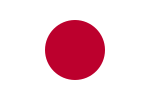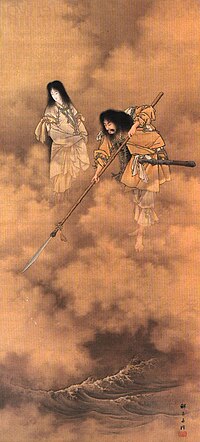The Shoku Nihongi (続日本紀) is an imperially-commissioned Japanese history text. Completed in 797, it is the second of the Six National Histories, coming...
3 KB (290 words) - 18:43, 11 September 2024
Nihon Shoki (redirect from Nihongi)
Shoku Nihongi notes that "先是一品舍人親王奉勅修日本紀。至是功成奏上。紀卅卷系圖一卷" in the part of May 720. It means "Up to that time, Prince Toneri had been compiling Nihongi on...
21 KB (2,290 words) - 02:12, 9 December 2024
His stay has been noted in the official history records called the Shoku Nihongi, where he is referred to as Bodai-Senna. Bodhisena was born in Madurai...
7 KB (796 words) - 06:38, 9 October 2024
Tōsandō region of central Honshu. According to the old history book Shoku Nihongi, it was established on June 26 of 721 and abolished on March 3 of 731...
2 KB (154 words) - 23:29, 19 November 2024
mentioned in the Shoku Nihongi's section on 769. Hyūga Hayato (日向隼人) A Hayato tribe who lived in Hyūga Province. The Shoku Nihongi records that in 710...
15 KB (2,020 words) - 18:57, 23 November 2024
are intermixed with legends and folklore. According to the chronicle Shoku Nihongi (797 AD), En no Ozunu was banished to the island of Izu Ōshima on June...
8 KB (906 words) - 19:32, 3 September 2024
during the Jōmon period. Buckwheat cultivation was first recorded in the Shoku Nihongi, in an imperial edict of 722 CE issued by Empress Genshō, instructing...
30 KB (3,097 words) - 05:52, 31 December 2024
flag reflect this central importance of the sun. The ancient history Shoku Nihongi says that Emperor Monmu used a flag representing the sun in his court...
115 KB (10,501 words) - 08:09, 3 January 2025
Japan; also called Nihongi) – 30 volumes covering the mythological period through 697. Completed by Toneri Shinnō in 720. Shoku Nihongi (Chronicle of Japan...
3 KB (329 words) - 17:33, 24 November 2024
Samurai in Japanese literature (section Shoku Nihongi)
before its introduction from Confucian China.[citation needed] The Shoku Nihongi (797 AD) is an early history of Japan compiled in 797. A section of...
36 KB (5,327 words) - 15:29, 15 October 2024
the Kofun period according to the Nihon Shoki (720), Kojiki (711) and Shoku Nihongi (797). According to ancient Japanese records, Nihon Shoki and Kojiki...
9 KB (1,153 words) - 00:20, 22 June 2024
Phillipi (1969). pp. 71–73. Aston, William George (1896). "Book I" . Nihongi: Chronicles of Japan from the Earliest Times to A.D. 697. Kegan Paul, Trench...
16 KB (1,815 words) - 01:37, 27 October 2024
in the Nihongi may also account for its rising popularity among samurai, since Ōjin was apotheosized as a god in Hachiman shrines. In the Nihongi account...
22 KB (2,561 words) - 05:34, 29 December 2024
kanji itself already could be seen in Shōsōin Monjo (8th century) and Shoku Nihongi (797) in Japan, and furthermore trace back in China, as early as 3rd...
16 KB (1,868 words) - 02:13, 28 October 2024
jurisdiction of the government office called Miki no Tsukasa. In the Shoku Nihongi, written in 797, there is a record of King Ashihara who got drunk and...
21 KB (2,195 words) - 12:47, 10 December 2024
style of writing, used in imperial edicts (宣命 senmyō) preserved in the Shoku Nihongi and other texts dating from the 8th century (Nara period), is known...
6 KB (604 words) - 02:43, 23 June 2024
Shinto and Buddhism. The first mention of this kami is found in the Shoku Nihongi as it contains the information that offerings were sent 794 CE to Hachiman...
17 KB (2,070 words) - 11:03, 4 January 2025
born prior to Shirakabe's ascension to the throne. According to the Shoku Nihongi (続日本紀), Yamabe's mother, Yamato no Niigasa (later called Takano no Niigasa)...
25 KB (2,816 words) - 21:36, 15 October 2024
in the deliberations of the heavenly deities. Ōmononushi (大物主神) in the Nihongi, Ōmononushi was considered an alternate name for Ōkuninushi. But, it appears...
31 KB (3,249 words) - 04:42, 25 November 2024
[Niigasa] was of the line of King Muryong of Baekje." According to the Shoku Nihongi, Niigasa was a descendant of Prince Junda, son of Muryeong. It was the...
3 KB (368 words) - 19:26, 30 May 2024
possession by the onryō spirit affecting health is found in the chronicle Shoku Nihongi (797), which states that "Fujiwara Hirotsugu (藤原広嗣)'s soul harmed Genbō...
22 KB (2,423 words) - 13:28, 17 December 2024
literature Kojiki (c. 711 CE) Nihon Shoki (720 CE) Fudoki (713–723 CE) Shoku Nihongi (797 CE) Kogo Shūi (807 CE) Kujiki (807–936 CE) Engishiki (927 CE) Shinto...
6 KB (644 words) - 00:40, 23 September 2024
decorations were used in Japan in the early 8th century. The history book Shoku Nihongi (797) states, "On January 1, in the 4th year of Tenpyō, Emperor Shōmu...
34 KB (4,392 words) - 08:19, 9 December 2024
literature Kojiki (c. 711 CE) Nihon Shoki (720 CE) Fudoki (713–723 CE) Shoku Nihongi (797 CE) Kogo Shūi (807 CE) Kujiki (807–936 CE) Engishiki (927 CE) Shinto...
100 KB (11,975 words) - 18:11, 30 November 2024
literature Kojiki (c. 711 CE) Nihon Shoki (720 CE) Fudoki (713–723 CE) Shoku Nihongi (797 CE) Kogo Shūi (807 CE) Kujiki (807–936 CE) Engishiki (927 CE) Shinto...
12 KB (1,351 words) - 23:30, 18 December 2024
literature Kojiki (c. 711 CE) Nihon Shoki (720 CE) Fudoki (713–723 CE) Shoku Nihongi (797 CE) Kogo Shūi (807 CE) Kujiki (807–936 CE) Engishiki (927 CE) Shinto...
5 KB (560 words) - 00:25, 2 September 2024
Rikkokushi or the Six Official Histories, includes Nihon shoki, Shoku nihongi, Nihon kōki, Shoku nihon kōki, Montoku jitsuroku, and Sandai jitsuroku. They chronicle...
17 KB (1,753 words) - 18:57, 10 December 2024
literature Kojiki (c. 711 CE) Nihon Shoki (720 CE) Fudoki (713–723 CE) Shoku Nihongi (797 CE) Kogo Shūi (807 CE) Kujiki (807–936 CE) Engishiki (927 CE) Shinto...
21 KB (2,354 words) - 07:30, 1 January 2025
general and shōgun of the early Heian period of Japan. According to the Shoku Nihongi, an official historical record, the Sakanoue clan is descended from...
43 KB (4,742 words) - 10:31, 27 November 2024
publicly referred a Korean blood in the imperial line. According to the Shoku Nihongi, Emperor Kanmu's mother, Takano no Niigasa (720 – 790) is a descendant...
7 KB (733 words) - 04:15, 12 November 2024





















